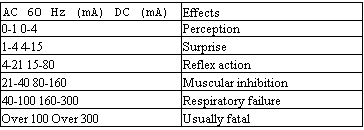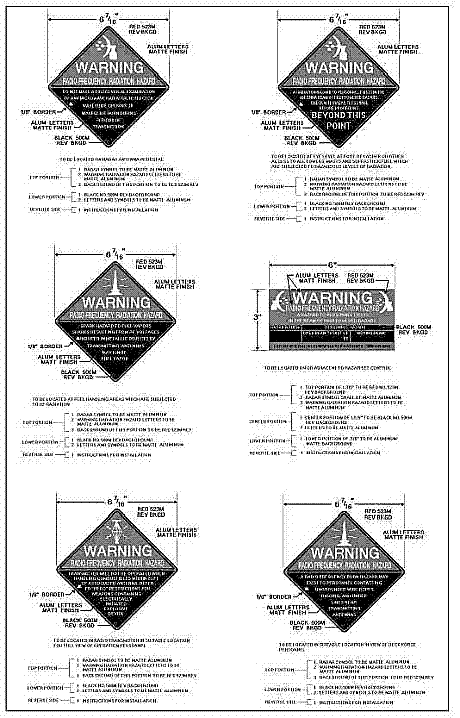Safety
EFFECTS OF CURRENT ON THE BODY
Before learning safety precautions, you should look at some of the possible effects of electrical current on the human body. The following table lists some of the probable effects of electrical current on the human body.

Table lists some of the probable effects of electrical current on the human body.
Note in the above chart that a current as low as 4 mA can be expected to cause a reflex action in the victim, usually causing the victim to jump away from the wire or other component supplying the current. While the current should produce nothing more than a tingle of the skin, the quick action of trying to get away from the source of this irritation could produce other effects (such as broken limbs or even death if a severe enough blow was received at a vital spot by the shock victim).
It is important for you to recognize that the resistance of the human body cannot be relied upon to prevent a fatal shock from a voltage as low as 115 volts or even less. Fatalities caused by human contact with 30 volts have been recorded. Tests have shown that body resistance under unfavorable conditions may be as low as 300 ohms, and possibly as low as 100 ohms (from temple to temple) if the skin is broken. Generally direct current is not considered as dangerous as an equal value of alternating current. This is evidenced by the fact that reasonably safe "let-go currents" for 60 hertz, alternating current, are 9.0 milliamperes for men and 6.0 milliamperes for women, while the corresponding values for direct current are 62.0 milliamperes for men and 41.0 milliamperes for women. Remember, the above table is a fist of probable effects. The actual severity of effects will depend on such things as the physical condition of the work area, the physiological condition and resistance of the body, and the area of the body through which the current flows. Thus, based on the above information, you MUST consider every voltage as being dangerous.
ELECTRIC SHOCK
Electric shock is a jarring, shaking sensation you
receive from contact with electricity. You usually feel like you have
received a sudden blow. If the voltage and resulting current are
sufficiently high, you may become unconscious. Severe burns may appear
on your skin at the place of contact; muscular spasms may occur, perhaps
causing you to clasp the apparatus or wire which caused the shock and
be unable to turn it loose.
RESCUE AND CARE OF SHOCK VICTIMS
The following procedures are recommended for rescue and care of electric shock victims:
Remove the victim from electrical contact at once, but DO NOT endanger yourself. You can do this by:
Throwing the switch if it is nearby Cutting the cable or wires to the apparatus, using an ax with a wooden handle while taking care to protect your eyes from the flash when the wires are severed Using a dry stick, rope, belt, coat, blanket, shirt or any other nonconductor of electricity, to drag or push the victim to safety
Determine
whether the victim is breathing. If the victim is not breathing, you
must apply artificial ventilation (respiration) without delay, even
though the victim may appear to be lifeless. DO NOT STOP ARTIFICIAL
RESPIRATION UNTIL MEDICAL AUTHORITY PRONOUNCES THE VICTIM DEAD.
Lay the victim face up. The feet should be about 12 inches higher than the head. Chest or head injuries require the head to be slightly elevated. If there is vomiting or if facial injuries have occurred which cause bleeding into the throat, the victim should be placed on the stomach with the head turned to one side and 6 to 12 inches lower than the feet.
Keep the victim warm. The injured person's body heat must be conserved. Keep the victim covered with one or more blankets, depending on the weather and the person's exposure to the elements. Artificial means of warming, such as hot water bottles should not be used.
Drugs, food, and liquids should not be administered if medical attention will be available within a short time. If necessary, liquids may be administered. Small amounts of warm salt water, tea or coffee should be used. Alcohol, opiates, and other depressant substances must never be administered.
Send for medical personnel (a doctor if available)
at once, but do NOT under any circumstances leave the victim until
medical help arrives.
SAFETY PRECAUTIONS FOR PREVENTING ELECTRIC SHOCK
You must observe the following safety precautions when working on electrical equipment:
Never work alone. Another person may save your life if you receive an electric shock. Work on energized circuits ONLY WHEN ABSOLUTELY NECESSARY. Power should be tagged out, using approved tagout procedures, at the nearest source of electricity. Stand on an approved insulating material, such as a rubber mat. Discharge power capacitors before working on deenergized equipment.
Remember, a capacitor is an electrical power storage device. When you must work on an energized circuit, wear rubber gloves and cover as much of your body as practical with an insulating material(such as shirt sleeves). This is especially important when you are working in a warm space where sweating may occur.
Deenergize equipment prior to hooking up or
removing test equipment. Work with only one hand inside the
equipment. Keep the other hand clear of all obstacles that may provide a
path, such as a ground, for current to flow. Wear safety goggles.
Sparks could damage your eyes, as could the cooling liquids in some
components such as transformers should they overheat and explode.
Keep a cool head and think about the possible consequences before
performing any action. Carelessness is the cause of most accidents.
Remember the best technician is NOT necessarily the fastest one, but the
one who will be on the job tomorrow.
RF SAFETY PRECAUTIONS
Although electromagnetic radiation from transmission lines and antennas is usually of insufficient strength to electrocute personnel, it can lead to other accidents and compound injuries. Voltages may be induced in ungrounded metal objects, such as wire guys, wire cable (hawser), hand rails, or ladders. If you come in contact with these objects, you could receive a shock or rf burn. This shock can cause you to jump or fall into nearby mechanical equipment or, when working aloft, to fall from an elevated work area. Take care to ensure that all transmission lines or antennas are deenergized before working near or on them.
Either check or have someone check all guys, cables, rails, and ladders around your work area for rf shock dangers. Use working aloft "chits" and safety harnesses for your own safety. Signing a "working aloft chit" signifies that all equipment is in a nonradiating status. The person who signs the chit should ensure that no rf danger exists in areas where you or other personnel will be working.
Nearby ships or parked aircraft are another source of rf energy that you must consider when you check a work area for safety. Combustible materials can be ignited and cause severe fires from arcs or heat generated by rf energy. Also, rf radiation can detonate ordnance devices by inducing currents in the internal wiring of the devices or in the external test equipment or leads connected to them.
ALWAYS obey rf radiation warning signs and keep a safe distance from radiating antennas. The six types of warning signs for rf radiation hazards are shown in the figure below.

Examples of rf radiation warning signs.
RF BURNS
Close or direct contact with rf transmission lines or
antennas may result in rf burns. These are usually deep, penetrating,
third-degree burns. To heal properly, these burns must heal from the
inside to the skin's surface. To prevent infection, you must give proper
attention to all rf burns, including the small "pinhole" burns.
Petrolatum gauze can be used to cover these burns temporarily, before
the injured person reports to medical facilities for further treatment.
DIELECTRIC HEATING
DIELECTRIC HEATING is the heating of an insulating material by placing it in a high-frequency electric field. The heat results from internal losses during the rapid reversal of polarization of molecules in the dielectric material.
In the case
of a human in an rf field, the body acts as a dielectric. If the power
in the rf field exceeds 10 milliwatts per centimeter, a person in that
field will have a noticeable rise in body temperature. The eyes are
highly susceptible to dielectric heating. For this reason, you should
not look directly into devices radiating rf energy. The vital organs of
the body also are susceptible to dielectric heating. For your own
safety, you must NOT stand directly in the path of rf radiating devices.
PRECAUTIONS WHEN WORKING ALOFT
When radio or radar antennas are energized by transmitters, you must not go aloft unless advance tests show that little or no danger exists. A casualty can occur from even a small spark drawn from a charged piece of metal or rigging. Although the spark itself may be harmless, the "surprise" may cause you to let go of the antenna involuntarily and you may fall. There is also a shock hazard if nearby antennas are energized.
Rotating antennas also might cause you to fall when you are working aloft. Motor safety switches controlling the motion of rotating antennas must be tagged and locked open before you go aloft near such antennas.
When working near a stack, you should draw and wear the recommended oxygen breathing apparatus. Among other toxic substances, stack gas contains carbon monoxide. Carbon monoxide is too unstable to build up to a high concentration in the open, but prolonged exposure to even small quantities is dangerous.















